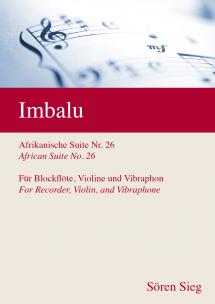Imbalu

African Suite No. 26
Für Blockflöte, Violine und Vibraphon
Score and three Parts
1st movement: Inemba
2nd movement: Lulwanda
3rd movement: Kamayiya
In August 2018 my son Jakob and I traveled through Uganda for three weeks. At the end of our journey, we were hosted by Racheal Namaganda in Mbale in the Northeast of Uganda. Together with her friends and her we visited the fabulous Sipii Waterfalls northeast of Mbale. On the way there we saw a huge crowd of people in traditional costumes dancing joyfully down the street. Racheal explained that this was IMBALU – the biggest celebration of the year for Racheal's tribe, the Bamasaba, that live around Mbale. IMBALU is an initiation ritual: the boys of the Bamasaba tribe who feel ready are circumcised – they are between six and ten years old - and thus become “real men”. The boys have to defeat pain and fear during this ritual; Racheal thinks this is the reason why her tribe has the strongest and most courageous fighters in Uganda. So, when in that same month Atria asked me to write a piece for them, I decided to write a piece about IMBALU, and it became my African Suite No. 26.
The first movement INEMBA is about the great expectations that precede the festival – the expectations of the boys, their families and the whole tribe. INEMBA itself is an instrument of the Bamasaba used during IMBALU. Racheal explains: “Inemba is a cultural instrument played when the boys are being finished to be circumcised, and the people will dance to their victory.” The instrument INEMBA resembles the marimba that is played here - by the way, our only orchestral instrument that arose and developed in Africa. An Arab traveler already described it in 1352 when he wrote about his journey through the kingdom of Mali.
The second movement LULWANDA is about the night before the festival: the boy is on the threshold of growing up. He will and must cross the threshold. With sadness he thinks back to the lightness and cheerfulness of childhood, playing with the other children, the lullabies of his mother. He says goodbye to weightlessness where time has stood still. A moving moment between melancholy and anticipation.
The third movement, Kamayiya, is about the festival itself. I quote a traditional melody that is sung during the ceremony.
Musically I mix African rhythms, drive, and energy with elements of French impressionism; in the composition process, I was very much inspired by the unique instrumentation of ATRIA and tried to let every of these rarely combined instruments “shine” and have its great moments.
On Youtube you find videos of the three movements that we recorded in December 2019 in the Music Conservatory of Bremen. I wish to thank Davíd Cisternas, Lukas Kuhn, and Inés Pina Pérez for their amazing performance.
This is the video of the first movement INEMBA:
https://youtu.be/WKivVuuYblU